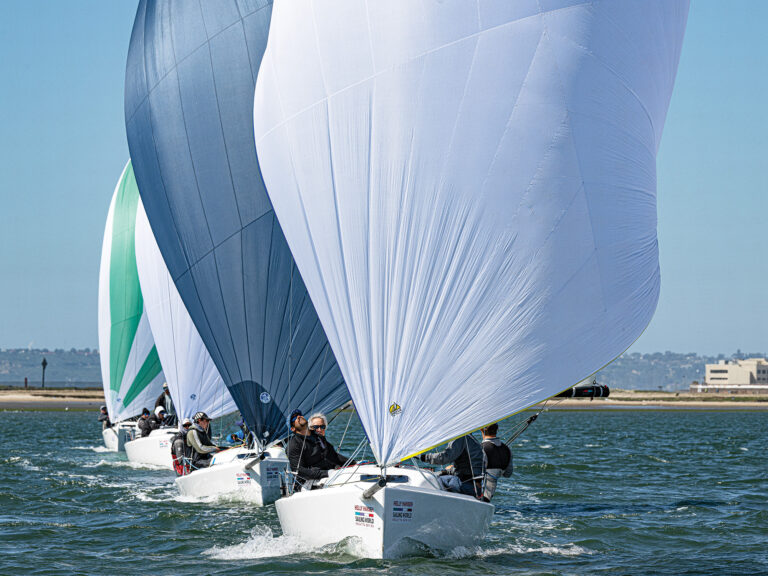The day before the start of the 2004 Chicago Mackinac Race was memorable for two reasons. We were practicing on the TP 52 Esmeralda in an 18- to 20-knot northerly with big waves-a great opportunity to get in some fast rides before the forecasted light upwind race. Secondly, it provided one of the coolest coaching experiences I had last summer. Esmeralda’s designer, Bruce Farr, was in town to have a look at his new design, and our skipper, Ken Read, had some specific questions regarding hull trim and crew placement. Our two-hour session was laboratory-perfect. We sailed upwind on the flat water inside the Chicago breakwater, with Coach Farr videotaping us from a borrowed powerboat. He was specifically looking at how the bow knuckle met the water when we moved bodies fore and aft. Then we popped through the breakwater into some classic Lake Michigan chop. After an hour of upwind work, it was time for the payoff. We bore away and put the 52 into rocket mode, setting three different asymmetric spinnakers in succession, and taking photos of sheeting angles and pole heights. That evening we gathered around Farr’s laptop to view the video and still photos. We quickly reached some solid conclusions, learning in two hours what we would have debated on board for an entire season. The goal of any successful racing program is to win races, but it’s an equally important goal to commit to your learning curve, to improving every day you go sailing. To this end, there’s nothing that will improve your sailing faster and more effectively than a good coach. It’s an essential part of any serious campaign, and it’s a lot more than coincidence that the best high school and college teams have dedicated and talented coaches. Many of the top grand-prix programs use coaches to keep up to speed, yet for more recreational sailors, hiring a coach is all but unheard of. It should be the first place to turn when looking to rise through the fleet’s pecking order. Having Bruce Farr on our team for the day was unique, but your coach doesn’t have to be a famous sailor. In fact, you can get great feedback from someone who isn’t a particularly fast racer, but has a good eye for detail. It’s easier than you think to find productive coaching for your team, but you first have to make the commitment to improve, decide what you are looking for in a coach, and know how to get the most out of the experience. Finding a Coach If you’re considering hiring a coach, it means setting aside practice time, and figuring the potential cost into your budget-more on that later. How you structure this time depends on your racing goals and your strengths and weaknesses. Get together with your crew and make three lists: racing goals for next season, where you are strong, and where you are weak. Be candid, and commit to improving all aspects of your team. For example, you seem to point higher on port tack than on starboard tack. You rounded three leeward marks last season with the spinnaker sheets over the bow and under the boat. You always seem a touch slower in the second race of the day, when the afternoon chop’s at its worst. List issues that have an obvious fix, so that your liabilities can be prioritized for next season (for example, you have speed problems in light air, but you have the oldest jib in the fleet). On small boats, weaknesses tend to be boatspeed or boathandling. On larger teams, communication comes up frequently as an issue. You may find it easier to break your issues down into three categories: tactics, boatspeed and sail trim, and boathandling. With your list of strengths and weaknesses, you can narrow down what you are looking for in a coach. If you are struggling with rig tune, or your sail trim is inconsistent, your sailmaker may be a good coach. It’s in his or her best interest to help you sail fast, and they should be willing to help, particularly if you’ve recently purchased sails. There is, however, a limit to how much ‘free’ coaching you should expect with a sail purchase. If you’re looking for specific input on tactics and communication, or detailed analysis of your boathandling, then an experienced professional sailor with a good eye is most likely what you need. There are no industry-standard fees for coaching, and costs can range widely. Most professional coaches charge between $200 and $500 per day. The top names will ask a higher fee. While a coach can be effective by hopping on board for a day of sailing, there is no substitute for an off-the-boat perspective, so you may want to factor in the costs of a powerboat and fuel. For any kind of rig-tune or sail-trim issues, a digital camera is also an effective tool. There isn’t a nationwide system for finding a coach, so get recommendations from your sailmaker, members of your local fleet, or sailors who have used one in the past. If you sail a popular one-design, contact the class’s national organization. As a last resort, or if your budget is really tight, look for a friend with a good eye for detail and a steady hand to take photos [For more on photo analysis of sail trim, see “Shooting From All The Right Angles,” p. 62, March ’04]. In fact, a sailor with good people skills and a calm, insightful demeanor may be more valuable as a coach than the local hotshot. What To Expect With a professional coach, you can expect an organized, productive day on the water, beginning with a meeting outlining the day’s plan, which the entire crew should attend. Outline goals for the session, based on the strengths and weaknesses you’ve identified. Tailor your plan to the weather forecast, and leave the dock with all the necessary food, water, and equipment. Downtime is a killer. Once you’re on the water, stick to the plan as much as possible without ignoring obvious spontaneous learning opportunities. Repetition is important, but be sure to make time at the end of the day for a detailed debrief, when most of the learning takes place. A good coach will lead the debrief, and know when to stand back and let the sailors discuss what they learned. A coach should not be there with all the answers, but to set up an environment where the team is learning as they go. What should the team bring to the practice session? A notebook, for starters, because ideas will come fast and furiously. Also, leave egos on the dock. Focus on improving, not showing the coach what you know. For future reference, I like to provide teams I coach with a detailed e-mail summary of the session, so that they can have my notes to refer to, as well as their own. Group and Race Coaching Training by yourself is valuable, but be wary of the conclusions you are making on your performance. It’s easy to feel fast when there’s no one sailing alongside you upwind, or pushing you at the leeward-mark roundings. “Playing your own hit record,” is Dennis Conner’s term for one-boat practice. A great way to improve the quality of the coaching is to add another boat or two. This works particularly well if you are looking for the champagne experience on a beer budget (see sidebar). Spreading the cost of a professional coach between other boats in your fleet saves money and can be an enormously productive way to improve, if you are willing to share the information with your competitors. Having a coach view a race can be productive, because he or she can watch you start, see the tactical situations unfold in real time, and get instant comparisons on the sail trim and speed of your competitors. If your practice time is limited, consider hiring a coach to watch a few races, and debrief afterwards. When I am coaching on a race day, I will get in close before the race to get a look at rig tune and sail trim throughout the fleet, and then watch the start, and see what is working tactically around the racecourse, for comparison with the team later. Like with most things in our sport, you get out what you put in. If you are organized with your coach you will see enormous benefits.









